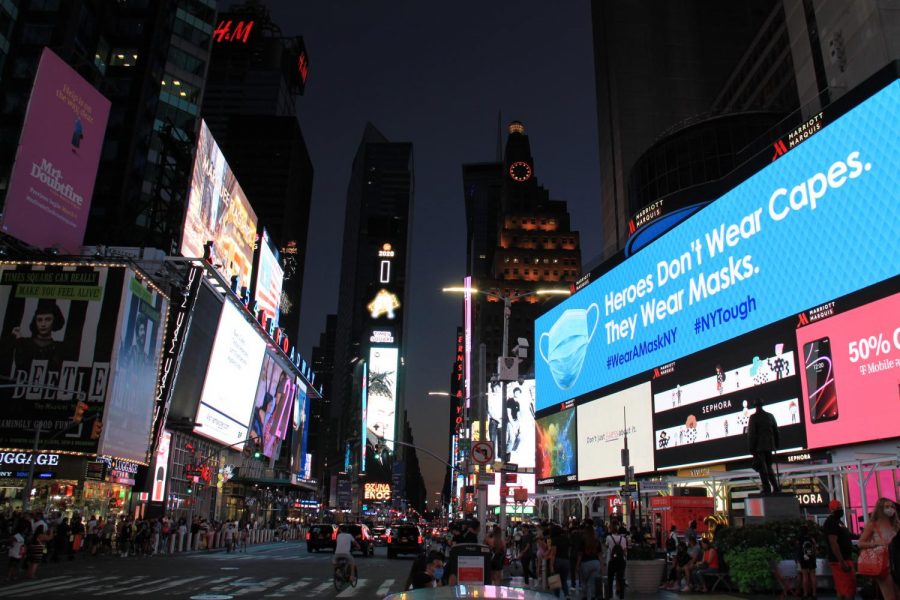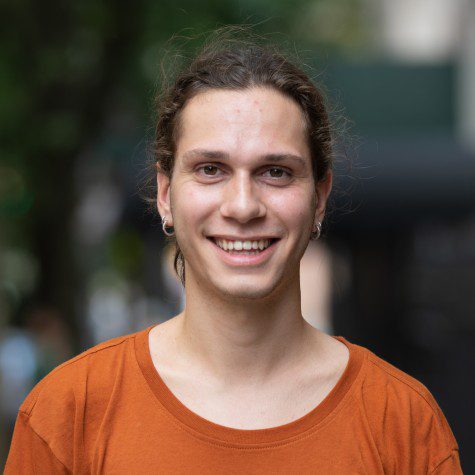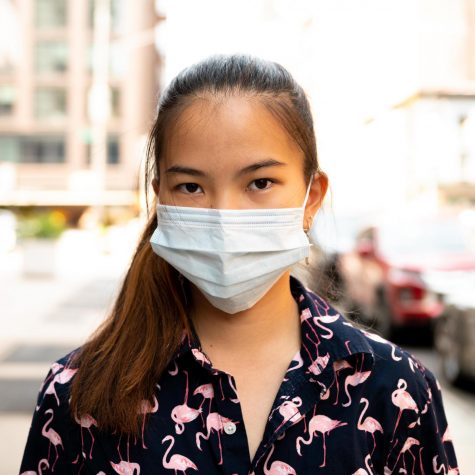Several NYU first-years gathered with about 200 other protesters in Times Square to protest United States Immigration and Customs Enforcement and demand its abolishment on Saturday, Sept. 19. The fourth protest in New York in four days — according to protesters on Friday and Saturday — was sparked by a whistleblower complaint alleging mass hysterectomies forcibly performed on detained immigrants. At least four NYU students attended the Times Square protest and at least three were arrested alongside nearly 90 other protesters.
The three students arrested were charged with disorderly conduct; one was also charged with obstruction of vehicular traffic and obstruction of pedestrian traffic.
On Wednesday, Sept. 16, protesters stormed a federal building housing FBI and ICE offices in Lower Manhattan; a security guard brandished and pointed a gun at the protesters. Two days later, protesters gathered at Foley Square, at 4 p.m., and clashed with NYPD officers outside of NYU’s Bobst Library and Kimmel Center for Student Life, at around 6 p.m. Officers made several arrests — they appeared to kneel on the back of one arrestee, a Black man — and used billy clubs and bike frames to bludgeon protesters off the sidewalk and into the street.
Protesters said these events were not advertised on social media to avoid heavy police presence. They planned them on a group chat on an encrypted messaging app, according to Siegrid Tuttle, a Gallatin first-year. Tuttle is a member of the chat along with Sarah Smith, also a Gallatin first-year, and more than 200 other people. Saturday’s protest, however, was advertised on Instagram — J.J. Briscoe, a Global Liberal Studies first-year, heard about the protest via Instagram. The publicity, according to Tuttle and Smith, was probably responsible for the NYPD’s heavy presence and the day’s violence.
At the Times Square protest, activist organizers spoke and a legal organization read a press release about the ICE detentions, Tuttle said.
“At that point we were already surrounded by police — like, hundreds of police,” Tuttle said. “We were all just rallying and listening to speakers for 20 or 30 minutes. In that time period, 100, maybe 200 cops had surrounded us with bikes. I think they already had a paddy wagon out.”
“They were already planning to arrest us,” she added.
Protesters tried to start marching after the speeches concluded, Briscoe said, but police officers confronted them and confiscated their bikes. Protesters use bikes to block traffic and provide security for fellow marchers. Marchers attempted to go the other way, but were blocked by more officers. When it became apparent they could not march, protesters decided to sit in the street.
Briscoe went with his friend Gladys Alberts, also a Global Liberal Studies first-year.
“We all go onto the street, we all link arms and then …,” Briscoe said. “They basically blocked us all in with NYPD bikes.”
Mass arrests began immediately, at about 1:30 p.m.
“I honestly don’t remember parts of it,” Alberts recounted. “It feels like it’s kind of been blocked out of my mind. That’s how traumatic events were … The police started coming in, and it was really clear from the beginning that they were just yanking people out of there. There was no regard for physical health or safety. They were wielding batons, some of them. They all had guns.”
“We were sitting there peacefully,” Alberts added. “We were not a threat to them. So the amount of violence they came in with was fully unfounded.”
Alberts’ arresting officer put their zip ties on too tight and they said they could not feel their hands. By the time they were released, their knuckles were blue; their wrists are still injured. Alberts’ arresting officer told them to change their position and move less. The officer did not know how to remove the zip ties and required a sergeant to loosen them. Alberts added that they believed many of the officers to have lacked confidence and competence.
According to Smith, protesters never intended to march but rather planned to occupy space and chant in the square to demand the abolishment of ICE. When bicyclists moved in to create a barrier between ralliers and police officers, officers arrested some bicyclists and confiscated their bikes. Protesters then tried to march out of Times Square, but officers and vans blocked them. An organizer sat down and protesters followed. Officers ordered them to cease obstructing vehicular traffic and started arresting them.
“[Police officers] essentially tried to go for protest organizers and weak links first,” Smith said. “They actually went around us to the back and started pulling people from the back and arresting them. And then they just were seeing people and just yanking them one by one. They would point to a person and be like, ‘Alright, if we can get that person out, then we can probably make this whole row fall.’”
Smith told WSN that at around 2:20 p.m., two police officers grabbed her legs and dragged her across the pavement. According to Smith, the arresting officer made numerous disparaging remarks to her and also took $21 in cash out of her wallet, joking that he was taking it from her.
“You’re not that smart, are you?” the arresting officer said, according to Smith. “You go to NYU, so you’re supposed to be smart.”
Upon Smith’s release, at around 8:30 p.m., the officer told her, “Since I gave you your money back, you should take that and buy Dunkin for the whole precinct for the trouble that you put us through.” While Smith was signing the papers, he asked her, “Are we done here? Or am I gonna have to pick you up off the streets again in another 30 minutes?”
“Sir, the conversation that I’m about to have to have with my mother is gonna take longer than 30 minutes,” Smith replied. “So I guarantee you won’t be seeing me again tonight.”
“Well, I have your phone right now and so I’ll call your mother for you,” Smith says the officer retorted. “I bet she’d be real proud of you right now.”
According to the students WSN spoke to, all the NYU students arrested were forced to remove their masks and stand shoulder to shoulder with their arresting officer for a photo. None of them were read their rights. There was no room for social distancing on the prison bus, but rather standing room only. Some protesters’ masks had fallen down during the arrests, according to Alberts; most NYPD sergeants weren’t wearing masks at all. Briscoe said about half the officers were wearing masks; the other half, not.
Minors were released from jail at around 6:30 p.m., according to several protesters including Alberts. Alberts was the last protester arrested at Times Square to be released. The rest of the protesters were released a little later, at around 8 or 9 p.m. Most protesters received peanut butter and jelly sandwiches while in jail, although no water, according to Smith. Alberts did not receive a sandwich and had to request food; officers gave them stale raisin bran.
The Office of the Deputy Commissioner, Public Information did not respond to requests for information on the NYPD’s deployment to the protests. They did not respond to requests for comment on officers’ conduct concerning the protesters.
Outside the jail, a support group awaited the protesters’ release with pizza and legal support. Police forced the group to move, declaring the area to be a “frozen zone,” and arrested a few of its members.
According to Izzy Capulong, a Gallatin first-year who was with the jail support group, the officers grabbed one girl by the hair, threw her to the ground and dragged her until her shirt was almost off. Alberts, who saw video of the incident, saw the same girl in jail, pulling clumps of torn hair from her head.
“I just remember that the police were smiling and laughing while they did it,” Tuttle said, referring to the arrests of the jail support group members. “In Times Square, they had completely stone faces because they didn’t want to look like they were enjoying it for the bystanders. But at [1] Police Plaza, it was clear that they like doing this and they think we should be injured for protesting for human rights.”
The police officers charged Smith, Alberts and Briscoe with disorderly conduct. Briscoe was additionally charged with obstructing vehicular and pedestrian traffic. Two police officers marched each protester five or ten blocks away from the jail before releasing them. The officers did not allow arrestees to put their laces — which they were required to remove — back on their shoes. Smith had to walk barefoot from 1 Police Plaza to the Brooklyn Bridge–City Hall Station.
Tuttle, Briscoe, Smith, Alberts and Capulong all said they were shaken yet undeterred.
“This issue of immigrant rights is inextricably linked to this issue of police brutality and just treating everyone in this city with respect and like their lives matter and like they have human rights,” Tuttle said. “When we say no human is illegal, the NYPD sees that as an attack on their personal values. Because they have a culture that stands in complete contrariness to the idea that any lives matter, really — that Black lives matter, that minority lives matter, that immigrant lives matter.”
Email Trace Miller at [email protected].
Correction, Sept. 24: A previous version of this article misspelled Gladys Alberts’ surname. The article has been updated and WSN regrets the error.

















































































































































